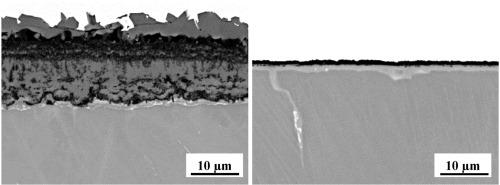Intermetallics ( IF 4.3 ) Pub Date : 2021-09-15 , DOI: 10.1016/j.intermet.2021.107270 Alexander Donchev 1 , Lukas Mengis 1 , Alain Couret 2 , Svea Mayer 3 , Helmut Clemens 3 , Mathias Galetz 1

|
Current limitations to a wider use of intermetallic TiAl alloys in aircraft and automotive engines arise from an insufficient oxidation resistance at temperatures above approximately 800 °C. In this paper, the high temperature oxidation behavior of three engineering γ-TiAl-based alloys at 900 °C in air is reported. The performance of the TNM alloy (Ti-43.5Al–4Nb–1Mo-0.1B), the 4822 alloy (Ti–48Al–2Cr–2Nb), and the Nb-free IRIS alloy (Ti–48Al–2W-0.08B) is compared (all chemical compositions are given in at.%). During testing in air non-protective mixed oxide scales developed on all untreated samples, but with different compositions and thicknesses. These different oxide layers are characterized and their formation mechanisms are discussed. The presence of W in the IRIS alloy leads to a better oxidation behavior compared to untreated TNM and 4822. This behavior was changed in the direction of a protective alumina layer formation via the so-called “fluorine effect”. The above-mentioned alloys were treated with fluorine via a liquid phase process by evenly spraying a fluorine containing polymer on all faces of the specimens. The oxidation resistance of the fluorine treated samples was significantly improved compared to the untreated specimens. Due to the fluorination all treated test coupons exhibited slow oxidation kinetics. The results of isothermal as well as thermocyclic exposure tests are presented and discussed in the view of the chemical composition and processing conditioned microstructure of the three investigated γ-TiAl-based alloys.
中文翻译:

钨合金化和氟化对航空航天用金属间钛铝化物氧化行为的影响
目前在飞机和汽车发动机中广泛使用金属间 TiAl 合金的限制是由于在大约 800°C 以上的温度下抗氧化性不足。本文对三种工程γ-报道了在 900 °C 空气中的 TiAl 基合金。TNM 合金 (Ti-43.5Al-4Nb-1Mo-0.1B)、4822 合金 (Ti-48Al-2Cr-2Nb) 和无 Nb IRIS 合金 (Ti-48Al-2W-0.08B) 的性能进行比较(所有化学成分均以 at.% 给出)。在空气中进行测试时,所有未经处理的样品都会产生非保护性混合氧化皮,但成分和厚度不同。对这些不同的氧化物层进行了表征并讨论了它们的形成机制。与未经处理的 TNM 和 4822 相比,IRIS 合金中 W 的存在导致更好的氧化行为。这种行为在通过所谓的“氟效应”形成保护性氧化铝层的方向上发生了变化。通过在试样的所有面上均匀地喷洒含氟聚合物,通过液相工艺对上述合金进行氟处理。与未经处理的样品相比,经过氟处理的样品的抗氧化性显着提高。由于氟化,所有处理过的试样都表现出缓慢的氧化动力学。从三种研究的 γ-TiAl 基合金的化学成分和加工条件微观结构的角度介绍和讨论等温和热循环暴露试验的结果。











































 京公网安备 11010802027423号
京公网安备 11010802027423号